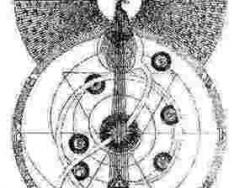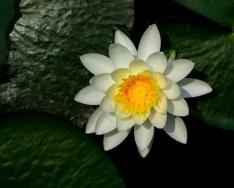And even if there was snow lying somewhere, soon all that was left of it was melt water, therefore, it was time to remove the sleigh until the next winter and turn out the shafts from them. They also went to Illarion to clean the ponds that had lost their ice cover.
The time had come for primroses, one of which - the coltsfoot - generously decorated the clearings with its yellow flowers and was so loved by the Russian people that they even created a legend about it. One day, a woman’s daughter, her beloved and only one, died. The mother's heart loved her so passionately that all the mother's affection and warmth went to her daughter's grave. When the woman had a stepdaughter, her treatment was completely different. And so great was the difference in the feelings of the stepmother and mother that a flower was born with leaves on two sides - the warm and velvety side turned to the ground, and upward, towards the whole world, the cool and smooth side.
Coltsfoot leaves have long been found in Russian herbalists, where they are recommended to be brewed as a tea in combination with other plants. So, for bronchitis - with chamomile, as a diaphoretic - with raspberries, for chest diseases - with oregano and marshmallow.
At the same time, as the primroses revealed their bright face to the world, Stepanov’s wreath lost its power. These wreaths, woven last August, on the 15th, by the whole family, decorated the red corner of the house, protecting the house from diseases, and if they did break through, you had to pick a blade of grass from the wreath and pour boiling water over it so that it would smell fragrant meadow, and this, they believed, was supposed to encourage a person to fight the disease.
Birthdays on this day.
The national holiday Hilarion - turn out the shafts is celebrated on April 10, 2020 (according to the old style - March 28). According to Orthodox church calendar this is the date of veneration of the memory of St. Hilarion the New, abbot of Pelicite.
The holiday got its name “turn out the shafts” because by this day the weather gets warmer and snow is no longer expected. This means that the time has come to put away the sleigh. To do this, they need to be freed from the shafts.
Story
Hilarion lived in the 8th century. Even in his youth, he decided to devote his life to serving the Lord. He spent many years in seclusion. For his righteousness and sinlessness, the Church awarded Hilarion the rank of priest, and later appointed him rector of the Pelicite monastery near the Dardanelles Strait.
He had the ability to work miracles, clairvoyance, healing and casting out demons. With the power of his faith, Hilarion called on rain, drove away pests from crops, filled nets with fish and healed those possessed by demons.
In 754, the monastery was attacked by the commander Lakhanodrakon, who was pursuing icon worshipers. He broke into the monastery on Maundy Thursday and caused a pogrom in the church: he interrupted the liturgy and threw bread and wine on the ground. 42 monks were chained and sent to execution in the city of Ephesus. The rest, among whom was Abbot Hilarion, were subjected to severe torture. God's people they beat them, broke bones, burned their beards, poured tar on their faces, and much more. Hilarion did not survive the torture. He left behind a spiritual legacy - instructions on spiritual life.
Traditions and rituals
On Hilarion, according to tradition, artificial reservoirs that have already been freed from ice by this time are cleaned. To prevent the merman from dragging you to the bottom, you must cross yourself.
On April 10, medicinal teas from coltsfoot are brewed. It is believed that this plant patronizes orphans, helps overcome loneliness, supports and warms. During this period, the coltsfoot buds begin to bloom. As soon as the flowers of the plant open, the “Stepanov’s wreath”, which was collected in mid-August, loses its magical power.
Signs
If dull and prolonged rumbles of thunder are heard, then long rains will soon begin.
Rain foretells a fruitful year.
If Hilarion has a foggy morning and frost, then vegetables, fruits and grains will grow.
If magpies are sitting on the tops of trees, it means that the frost will soon subside.
The lapwing flies low in the evening and screams - there will be no rain in the summer.
Seagulls fly over the houses - the ice on the river will soon melt.
Hilarion – folk holiday in Rus', was called so for the reason that on this day Christian Church remembers Saint Hilarion. It was believed that Hilarion patronized those who decided to get married and live according to the canons of the church, saving them from adversity and troubles.
In peasant life this day had special meaning. It was on this day that the first primroses bloomed and the bees began collecting honey. People said that as much as the honey from primroses, so does the bribe in the summer. If the weather was damp and cold, they said: “Don’t expect honey in the summer, since the weather let down Hilarion.”
Mothers wove wreaths from mother and stepmother for their daughters, which they then hid in a women's corner or chest until the next Hilarion, so that their daughters would not have troubles and illnesses this year.
The name “turn the shafts out” stuck to this day because the peasants put the sleighs in summer storage and turned the shafts up on them.
We noted from the weather that day whether there would be rain in June. If it rained or snowed, they said that June would also be rich in rain.
Hilarion - Turn out the shafts - holiday folk calendar, which is not included in the register of memorable and holiday dates of the Russian Federation.
Each of us, one way or another, believes in miracles, even if we deny this fact. We are all children at heart, dreaming of magically getting what we want. Then joy, peace and tranquility will reign in the heart... However, those of us who are Orthodox Christians and truly believe in God do not doubt the existence of miracles in reality. However, in addition to everything, he knows for sure: the Lord and His chosen ones, that is, the saints, can accomplish the latter. These people led a pious lifestyle and were honored to have acquired one or another gift: healing illnesses, causing rain, resurrecting the dead, etc. This article will focus on just such an ascetic - on April 10, the church honors the memory of St. Hilarion the New, abbot of Pelicite.
Life of Saint Hilarion
God's chosen one Hilarion came from a pious family. His parents Peter and Theodosius were Christians, and therefore from infancy they instilled in their son the canons and dogmas of a righteous life, and sought to arouse in the child’s soul a sincere, fiery love for the Lord. They succeeded in this as well as possible. Little Hilarion, under the influence of his father and mother, invariably imitated, while still a youth with a fragile soul, Gospel commandments about bliss. Gradually, he became so accustomed to seeing God in everything and relying on him that he decided, obeying the voice of his heart, to devote his earthly existence to the Creator. For this purpose, having reached the age of 20 and having received his parental blessing, he left father's house and became a monk. First, the young man settled in the Hesychia monastery, located not far from Byzantium.

After some time, the ascetic retired to the Dalmatian monastery. Other sources indicate the Pelicite monastery near the Dardanelles Strait. Most likely, this means the same monastery. In any case, there the ascetic of piety accepted the great schema and found a teacher - Gregory Decapolite. There was another person who was in many ways an example for St. Hilarion the New. This is the namesake of the saint - St. Hilarion the Great. In essence, because of the imitation of the ascetic life of the indicated person, our Hilarion was called New.
For his good deeds and deep devotion to the Lord, the future monk first became a presbyter, and a little later - hegumen of the Pelikite monastery. But this did not happen right away, because in his young years, having just become a monk, Saint Hilarion went into seclusion for a long time and led a hermit’s lifestyle. Thanks to the demonstration of humility and meekness before the will of God, acquisitiveness and many other virtues, the monk acquired from the Lord the ability to perform miracles. They took place after a fiery prayer offered to the saint. The Monk Hilarion caused rain in times of drought and protected fields from insect pests and animals that posed a threat to the crops. The saint miraculously filled the nets of fishermen with an excellent catch when they suffered without fish. He could divide the waters of the river, in which he was similar to the Old Testament prophet Elisha, who lived in the 9th century BC near the Jordan. In addition to all of the above, the saint healed the sick with prayer and cast out demons.
Death of the ascetic Hilarion
There is no exact, unambiguous information about how the Monk Hilarion ended his days. Perhaps this is due to some confusion that arose due to the existence of more than one saint who bore the name Hilarion and lived around the same time as the hero of our story. One way or another, both versions of what happened many centuries ago will have to be presented.

According to the first, Hilarion the New, abbot of Pelicite, suffered in 754, on Maundy Thursday, because of the veneration of icons. On this day, the military leader Lakhanodrakon burst into the monastery, where by that time the monk served as abbot. His goal was the persecution and destruction of icon worshipers. The wicked man suddenly attacked the Pelicite monastery, at the moment Divine Liturgy. The service, of course, was interrupted. Moreover, the Holy Gifts, through the efforts of the Lachandragon, flew to the ground, but, worst of all, part of the monks, 42 people in total, were captured, chained, exiled to the Ephesus region and put to death. The remaining monks, led by Abbot Hilarion the New, also faced an unenviable fate: they were severely beaten, their hair was burned, some had their noses cut off and their faces smeared with tar. It was as a result of this nightmare, perpetrated by the atheist Lakhanodrakon and his minions, that the abbot of the monastery, Venerable Hilarion, died in terrible agony.
Another version has a similar ending, but consecrates the current events leading to the death of Abbot Pelicitsky somewhat differently. Firstly, if you believe her, then it all started with the election of Hilarion the New as abbot of the Dalmatian monastery. After the death of the former rector, the brethren clearly wanted to see Hilarion in this position, who was already a presbyter by that time. But he, having learned about the intentions of the monks, secretly retired to Byzantium. This did not stop the monks: in order to implement their plan, they sent Nikifor, the saint and Patriarch, a petition for the appointment Reverend Abbot. Clergyman found the saint and, citing various arguments, managed to convince the saint to take the position offered to him. Hilarion the New obeyed, but not out of his own desire, but out of holy obedience.
He was the abbot of the monastery for 8 years, and all these years he faithfully served God and the brethren.

A sharp deterioration in the situation in the country regarding society's attitude towards Christianity occurred in 813, with the coming to power of Leo the Armenian (813-820). This cruel man was an iconoclast. It is clear that the Monk Hilarion the New suffered from the new ruler and his ideology. The ascetic refused to blaspheme the holy images. The monk also fearlessly accused the iconoclast ruler of heresy, for which he was beaten, then thrown into prison, deprived of food and water.
The situation was further aggravated by the fact that the place of Patriarch Nicephorus, who stood up for Christianity, favored the monk and was expelled for his views by the new ruler, was taken by the wicked Theodotus. The latter especially tormented Hilarion with torments and tortures so that he would renounce Christ and Orthodoxy. The monks of the Dalmatian monastery stood up for their abbot. Appearing to the emperor, they turned to him with a request to leave the monk alone, guaranteeing that he would obey the will of the ruler. And they achieved their goal: Hilarion the New was released. However, as soon as he and the monks crossed the threshold of their native monastery, they again began to hold services and honor the holy images. The emperor learned of the broken promise and again put the monk behind bars, periodically torturing him. This went on for some time.
As a result, Hilarion was released by the new Emperor Michael II the Tongue-Tie. The former ruler became a victim of his own fighters: they chopped him into pieces in the temple. The monk settled in solitude. Under Emperor Theophilus, the saint again found himself in captivity, now on the island of Afusia. But Empress Theodora, after the death of the ruler, granted Hilarion the New freedom. He returned to his monastery and in 845 peacefully departed to the Lord.
About him


